Technically, the English Regency—when George IV acted as regent for his father George III—lasted only from 1811 to 1820, yet the period’s popularity in popular culture, especially in genre literature, is much bigger than its brief duration in time would suggest. What makes this period so significant and well-loved?
The Regency period was is a critical hinge point in English history and especially in English culture. It was a time of great social, political, economic, artistic, and technological change, largely driven by the Napoleonic Wars. In addition to the political changes arising from the aftereffects of the American and French Revolutions and the domination of Europe by Napoleon, the Regency saw significant new developments in art, architecture, and fashion, largely driven by the Regent himself; a population boom and corresponding economic expansion; and a vibrant and highly stratified social scene populated by larger-than-life characters like Beau Brummell, Horatio Nelson, Ada Lovelace, and Mary Shelley. All of these things make it a significant and emotionally resonant era and a great time period for historical fiction.
One of the most significant technological innovations of the period was the steam-powered printing press, which drove the rise of fashionable novels—including romans à clef written anonymously by members of the aristocracy—which made the lives of the rich widely available as popular entertainment for the lower classes. These cheap and popular novels, many of which were published after the Regency ended, cemented the life of the upper classes in the Regency as a specific literary genre, and shaped the future growth of the novel itself.
Much of the credit, or blame, for the Regency’s popularity today can be laid at the feet of Georgette Heyer, who popularized a certain view of the period through her Regency romances, beginning with Regency Buck in 1935, which became best-sellers in the UK, US, and elsewhere in the 1950s and 1960s. Heyer combined historical accuracy with the verve, wit, and humor of Jane Austen, but also added a twentieth-century sensibility and certain quirks (such as a specific set of slang) that flavored the public’s understanding of the period for a generation. I haven’t read Heyer myself [hangs head in shame] but there’s no question her influence is wide and pervasive.
Here are five books about the Regency, which are among my favorites and influenced my “Regency interplanetary airship adventure” novel Arabella of Mars.
Our Tempestuous Day: A History Of Regency England by Carolly Erickson
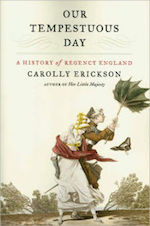 I’d like to lead off with a non-fiction title, because the actual Regency is so much richer and weirder than anything you’ll find in fiction. This is a particularly lively and readable social history of the era, focused on the larger-than-life personalities such as Lord Byron and the Prince Regent himself. It’s a quick read, and I’d recommend it to anyone interested in the period.
I’d like to lead off with a non-fiction title, because the actual Regency is so much richer and weirder than anything you’ll find in fiction. This is a particularly lively and readable social history of the era, focused on the larger-than-life personalities such as Lord Byron and the Prince Regent himself. It’s a quick read, and I’d recommend it to anyone interested in the period.
Master & Commander by Patrick O’Brian
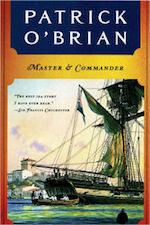 O’Brian’s Aubrey/Maturin books—this is the first in a series of twenty novels—were my own personal introduction to the Napoleonic Wars, and my primary model in writing Arabella of Mars. Painstakingly researched and written in period idiom, these historical novels appeal to many SF readers (despite the lack of any fantastic element) because they incorporate an SF-like degree of worldbuilding that makes them a delicious experience of another place and time. They are also cracking adventures and, like Austen, surprisingly funny.
O’Brian’s Aubrey/Maturin books—this is the first in a series of twenty novels—were my own personal introduction to the Napoleonic Wars, and my primary model in writing Arabella of Mars. Painstakingly researched and written in period idiom, these historical novels appeal to many SF readers (despite the lack of any fantastic element) because they incorporate an SF-like degree of worldbuilding that makes them a delicious experience of another place and time. They are also cracking adventures and, like Austen, surprisingly funny.
Jonathan Strange & Mr Norrell by Susanna Clarke
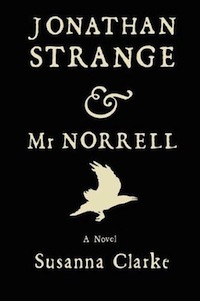 This enormous and beautifully crafted standalone novel (which, though I love every detail, would have been improved by being considerably shorter) combines the actual drama of the Napoleonic Wars with a grand story of the recovery of English magic after a long period of decline. In a sense it makes the Regency even more itself, by amplifying the period’s actual cultural and economic changes with an additional set of magical changes.
This enormous and beautifully crafted standalone novel (which, though I love every detail, would have been improved by being considerably shorter) combines the actual drama of the Napoleonic Wars with a grand story of the recovery of English magic after a long period of decline. In a sense it makes the Regency even more itself, by amplifying the period’s actual cultural and economic changes with an additional set of magical changes.
Shades of Milk & Honey by Mary Robinette Kowal
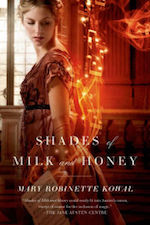 This novel has often, and justifiably, been described as “Jane Austen with magic.” A delightful exploration of the impact of a gentle magic of illusion, called “glamour,” quite in contrast with the warrior magic seen in Jonathan Strange & Mr Norrell, it combines a wonderfully suspenseful romance with a science-fictional extrapolation of the impact of this seemingly minor change on society. This is the first in a series of five, called the Glamourist Histories, and combines rigorous research with a subtle critique of the period’s mores and norms.
This novel has often, and justifiably, been described as “Jane Austen with magic.” A delightful exploration of the impact of a gentle magic of illusion, called “glamour,” quite in contrast with the warrior magic seen in Jonathan Strange & Mr Norrell, it combines a wonderfully suspenseful romance with a science-fictional extrapolation of the impact of this seemingly minor change on society. This is the first in a series of five, called the Glamourist Histories, and combines rigorous research with a subtle critique of the period’s mores and norms.
His Majesty’s Dragon by Naomi Novik
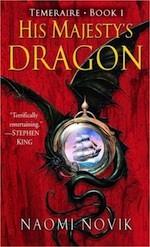 If Shades of Milk & Honey is Jane Austen with magic, this is Patrick O’Brian with dragons. A high-stakes adventure in which our main character, a young sea captain, finds himself forced by circumstance into the aerial corps—a great loss of status—but in compensation gains the deep friendship of a gigantic, powerful, intelligent, but naive flying weapon. This is the first of nine books, which explore the whole world and the length and breadth of the Napoleonic Wars in an alternate history almost unchanged from ours except for the introduction of dragons.
If Shades of Milk & Honey is Jane Austen with magic, this is Patrick O’Brian with dragons. A high-stakes adventure in which our main character, a young sea captain, finds himself forced by circumstance into the aerial corps—a great loss of status—but in compensation gains the deep friendship of a gigantic, powerful, intelligent, but naive flying weapon. This is the first of nine books, which explore the whole world and the length and breadth of the Napoleonic Wars in an alternate history almost unchanged from ours except for the introduction of dragons.
Happy reading!
See Sherwood Smith’s blog post “The Romance of the Regency: Jane Austen, Georgette Heyer, and Silver Fork Novels” for more information on this fascinating topic.
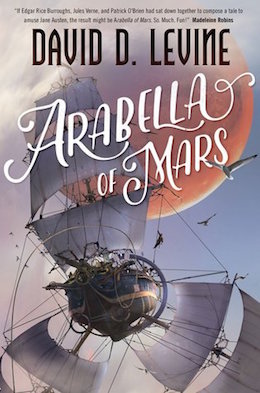 David D. Levine is the author of the novel Arabella of Mars and over fifty science fiction and fantasy stories. His story “Tk’Tk’Tk” won the Hugo Award, and he has been shortlisted for awards including the Hugo, Nebula, Campbell, and Sturgeon. Stories have appeared in Asimov’s, Analog, F&SF, Tor.com, numerous Year’s Best anthologies, and his award-winning collection Space Magic.
David D. Levine is the author of the novel Arabella of Mars and over fifty science fiction and fantasy stories. His story “Tk’Tk’Tk” won the Hugo Award, and he has been shortlisted for awards including the Hugo, Nebula, Campbell, and Sturgeon. Stories have appeared in Asimov’s, Analog, F&SF, Tor.com, numerous Year’s Best anthologies, and his award-winning collection Space Magic.










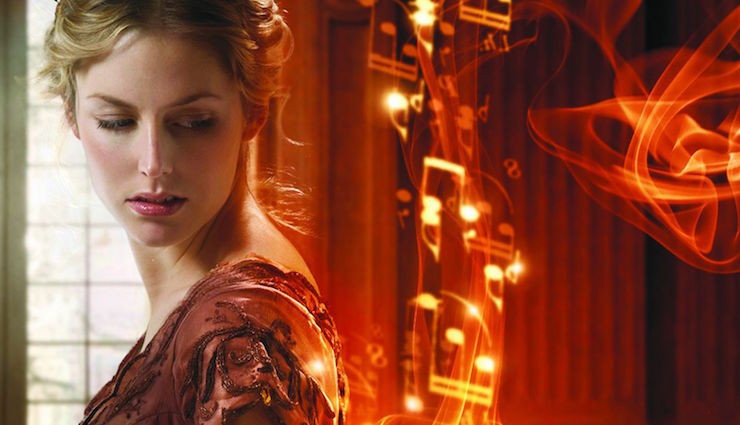
You’ve finally done it. I’ve been hovering around that Patrick O’Brien series for years. It has been recommended by tons of people and even though it sounds like something I’d like, something keeps holding me back. Well, I’ve just put the first book on hold at the library. So thanks for that!
Sharon Lee & Steve Miller’s Liaden science fiction series is very much the Regency period in space.
SORCERY AND CECELIA: OR THE ENCHANTED CHOCOLATE POT, Patricia C. Wrede and Caroline Stevermer. Regency-based historical fantasy.
MAIRELON THE MAGICIAN, Patricia C. Wrede. Young adult historical fantasy. Alternate Regency period with magic.
Oh, and, if you enjoy the O’Brian series, try the Horatio Hornblower series by CS Forester. A classic series, and Hornblower is one of the inspirations for Captain Kirk in STAR TREK.
I’m so glad you have the Glamourist Histories listed here! I love Mary’s take on the time.
For those not familiar, the first book reads like a more typical Jane Austen romance. But then the world cracks open. She deals with Napoleon, classism, racism, the distrust of Catholics, and even slavery in the final book.
Once done reading check out her Writing Excuses podcast where she goes in-depth on the stories. Sorry I can’t post a link, my computer is having issues.
Galen Beckett has good series that is like Glamourist Histories, with a darker alternate world. Yet if you like mixing Austen and magic, The Magicians and Mrs. Quent is worth reading.
@2: I love Patricia C. Wrede! I wish she had more completed works.
I used to sneer at romance novels until I had to clear out my late MIL’s library. She was a very down-to-earth person, so her liking for those Heyer books had always puzzled me. I cracked one open…and three hours later I was still sitting on the steps giggling. Heyer has her off moments, but when she’s on, she’s on. Some of my favorites:
Sylvester, or the Wicked Uncle: The anonymous authoress, the jerk who found himself used as the physical model for her over-the-top villain, and the bubbleheaded fangirl with connections to both of them. Any novel that features (ROT13) Ze. Hasynccnoyr ZpZnfgreshy ernyvmvat gung ur unf pbzcyrgryl ehvarq uvf punaprf bs trggvat gur vatrahr gb rire gnyx gb uvz ntnva naq ehaavat ubzr gb fbo vagb uvf zbgure’f ync nobhg jung n fperjhc ur’f orra has got to be good.
Venetia: The sheltered orphaned innocent, her poor crippled brother, the country stalwart, the dashing young savior, and the dissolute rake–except that not a word of what I said is actually true.
Black Sheep: Three sheltered sisters and their orphaned niece find themselves embroiled in a feud between an upright and honorable man and his dissolute, scheming relative.
Frederica: A contented bachelor finds himself thrown headlong into the life of a young woman who is attempting to launch her younger sister into Society while corraling her workaholic younger brother, her youngest brother the budding mad scientist, and a large dog. A balloon chase is involved.
The Corinthian: A treatment of “rich man with a secret courts the governess” that is 180 degrees from Jane Eyre. Features deftly sketched supporting characters and the most awful brat I ever met in fiction.
“in an alternate history almost unchanged from ours except for the introduction of dragons.”
I have to disagree with you on this point. Novik does a terrific job of examining myriad ways in which the addition of indigenous air power, varying in types and levels of domestication across geographic areas and cultures, affects the “history” of the era. I mean, a world in which North and South America remain uncolonized by Europeans and under the control of their indigenous cultures is hardly an insignificant change in history…
Kowal’s books are wonderful, especially Valour and Vanity. She doesn’t shy away from giving Jane period appropriate prejudices and then organically correcting them. The later books especially pack an enormous amount of feeling into them. Not that the first books are bad, you just lived with Jane and Vincent’s struggles longer by the time you get to those later moments.
I highly recommend Sylvia Izzo Hunter’s “The Midnight Queen”. It takes place in an very alternative Regency- for one, there’s a functioning monarch, so it’s not really a regency and there’s no Napoleonic war or anything close to it. But the writing style, tech level, and the behavior and social structure of the characters would certainly place it as a fantasy Regency.
Heyer’s “An Infamous Army” should be read by as many people as possible, if only so that their brains can explode at the fact that they’re reading a romance novel that’s on the required reading list at Sandhurst.
Now there’s a novelist who did her research.
Cecilia and the Enchanted Chocolate Pot is a favorite. I’m not certain of it’s degree historical accuracy (this is my own ignorance and not a criticism of the authors,) but it is hilarious, and brings magic very much down to earth. Also, two very different romances for the price of one!
English Regency? What happened to Scotland? It’s not like it was more than a century after the 1707 Act of Union or anything…
@3: Based on my love of the O’brien novels I tried reading Hornblower, but just can’t get into them. Mainly because I dislike the main character, I think.
Also, Jonathan Strange & Mr. Norrell is one of my all time favorites. I recently read the Sorcerer to the Crown by Zen Cho based on someone telling me it was similar and ended up hating it. Once again, I didn’t like the main character and 9/10 times that kills it for me (Name of the Wind is one exception I can think of)
@Stam Fordley
In the sequel to “The Midnight Queen, “Lady of Magic”, the characters go to Scotland.
A few thoughts:
* If you’re new to O’Brian’s Aubrey/Maturin series, stick with it past Master and Commander. It’s not held to be a strong start (I for one had trouble connecting with at least one of the duo). But the second book will grab you and pull you in for the voyage.
* @@@@@Jenny Islander, you’ve named my favorite Georgette Heyer books, and a few I may not have read – I’ll have to seek them out. I think of her books as sweet treats.
* @@@@@LN, I agree with you about how far Novik takes alternate history in the Temeraire series. That doesn’t start to show in His Majesty’s Dragon, however, until almost the end of that book (when a major historical figure does not die in a major battle, and thus plays a role in several more of the books). The big shifts really start in the fourth book, Empire of Ivory.
This is a timely article. I’d just finished the last Temeraire book, and was wondering to myself why so many books and series are set during the Regency.
Since we may have a few new readers getting into the Aubrey Maturin books: Jo Walton did a series of read-along posts about the series a few years ago. (Mentioning it here because I may take this opportunity to finally read them myself!)
@@@@@Jenny Islander, those are great Georgette Heyer books, but that last one sounds like the Nonesuch, not the Corinthian (the plot of which is: drunken aristocrat evades arranged marriage by helping heiress disguised as boy flee from her relatives – encountering murder, stolen diamonds and other mayhem on the way)
The Lady Trent books by Marie Brenan may be written in a fantasy land with all the serial numbers filed off, but it’s still clearly Regency.
Also I would suggest some of the Watch books of the Discworld qualify.
And of course Bujold’s A Civil Campaign is often discribed as a Regency Romance with Spaceships (which does it a disservice, but the best books can never be simplified to a single sentence)